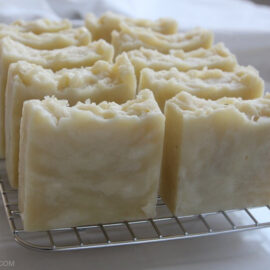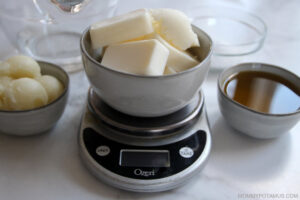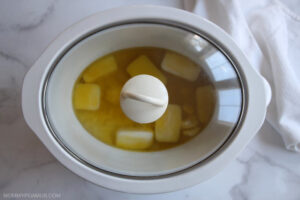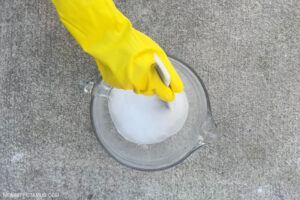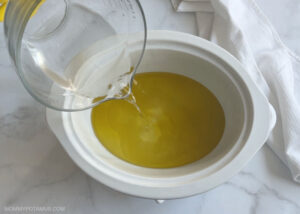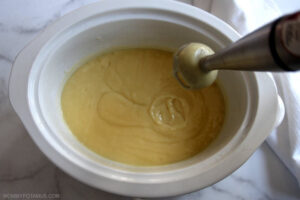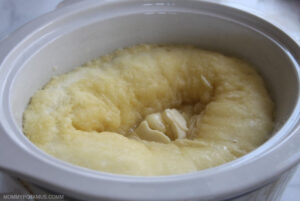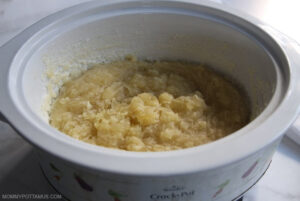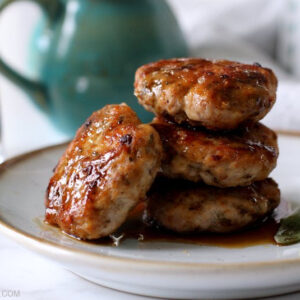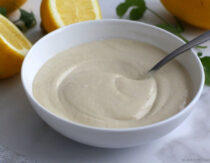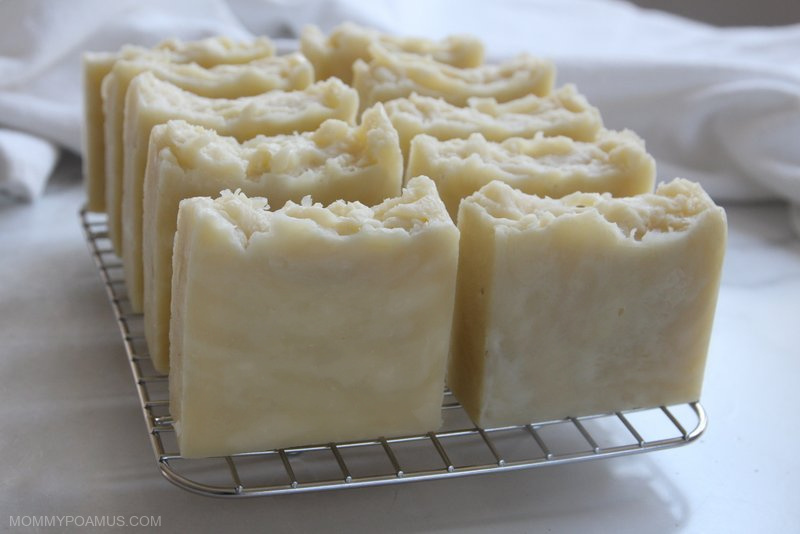
If you’re new to soap making, or just love using easy-to-find ingredients that lather beautifully, this simple tallow soap is well worth making.
Tallow is uniquely compatible with our biology, making it a popular skincare ingredient in formulas like this face balm and, of course, homemade soap.
Like most animal fats, tallow creates a hard, long-lasting bar that’s deeply cleansing. In this formula I’ve blended it with moisturizing olive oil and a bit of coconut oil for fluffy lather, making it perfect for skin of all types, even sensitive skin.
Easy Tallow Soap Recipe (Hot Process Method)
This recipe creates a long-lasting, moisturizing bar with fluffy lather, and it’s easy to make. Scroll to the bottom of this article for a printable version.
Ingredients:
All amounts are per weight. You will need to use a scale for these measurements.
- 15 ounces beef tallow (click here for my guide to rendering tallow)
- 7.5 ounces coconut oil
- 7.5 ounces olive oil
- 11.4 ounces distilled water
- 4.3 ounces lye crystals (known as sodium hydroxide or NaOH)
- 1/2 – 1 ounce essential oil (optional)
Equipment Needed:
According to Anne Watson, author of Smart Soapmaking, you can use your regular kitchen utensils as long as you follow the guidelines in this article.
- 8 quart slow cooker/crock pot
- Immersion blender
- Digital scale
- Glass measuring cups
- Bowl for measuring your tallow
- Medium-size heat resistant glass bowl for mixing the lye water
- Stainless steel or plastic spoon with long handle
- Silicone mixing spatula (optional)
- Protective equipment: shirt with long sleeves, plastic/rubber gloves, safety glasses or protective eye gear
- Soap mold – A standard sized bread pan will work for this batch, or you can use a flexible silicone mold like this one.. If you use a bread pan instead of a flexible mold that easily pops out the soap, just make sure to line it with parchment paper so you can easily lift the soap out.
- Thermometer (Optional – only needed if you’re adding essential oils)
- Sink filled with hot soapy water (For cleaning anything that comes in contact with lye. Wait until you’re ready to clean to fill the sink. Details below)
Step 1: Measure Your Ingredients
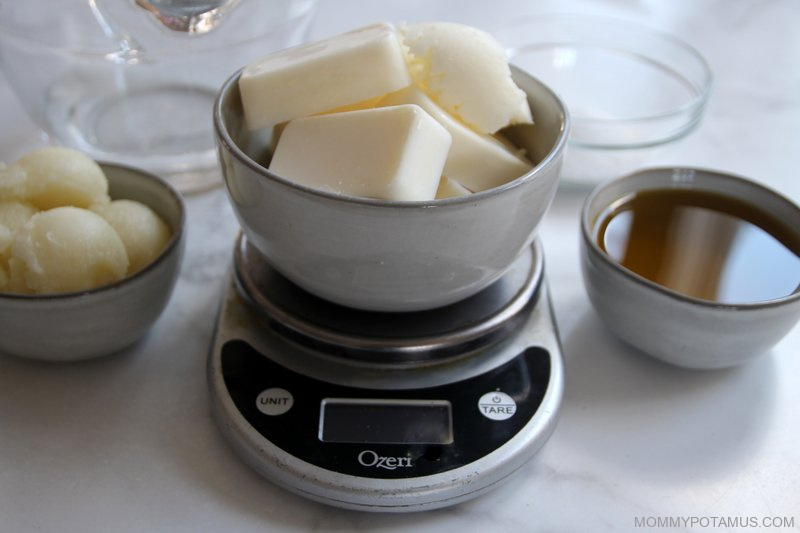
Weigh all your ingredients: tallow, coconut oil, olive oil, distilled water, lye and optional essential oils if using.
Step 2: Melt The Tallow & Oils
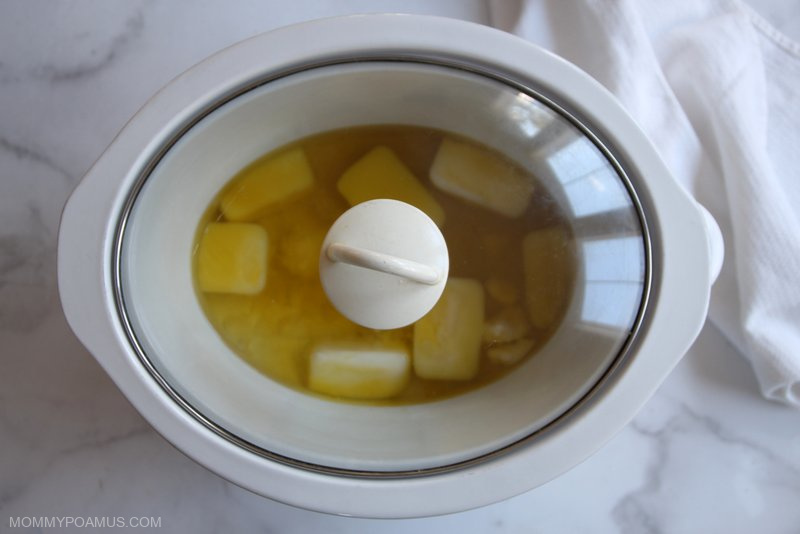
Add the tallow, coconut oil and olive oil to the slow cooker and set it to low heat. When they are almost fully melted move on to step 3.
Step 3: Mix The Lye Water
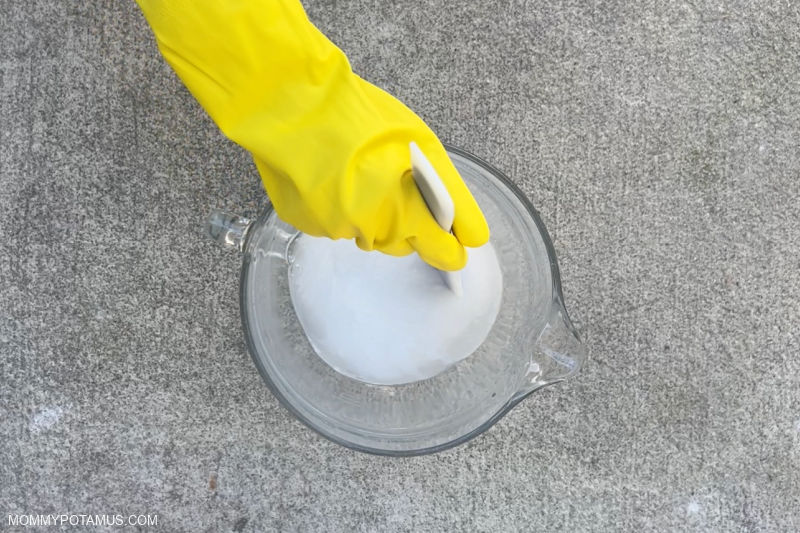
Make sure that kids and pets do not have access to the lye water you are about to make, then put on your protective gear and add your water to a medium-sized heat-resistant glass or ceramic bowl.
Choose a well-ventilated area to mix in the lye. I prefer to mix outside, but some soapers like to mix in their kitchen sink with several open windows and a fan or air purifier running. If you’re new to working with lye, see the FAQ section for safety information.
Make sure you have a long-handled spoon or spatula ready. I use a this silicone spatula/scraper.
While wearing your protective gear and taking care not to breathe the vapors, slowly add the lye to the water while mixing gently. Order is important here, so make sure it is the lye you’re pouring into the water.
Keep stirring until the lye seems mostly dissolved. The mixture will be cloudy at first, but will turn clear in 5-10 minutes. When it’s clear, go to step 4.
Step 4: Add The Lye Mixture To The Slow Cooker
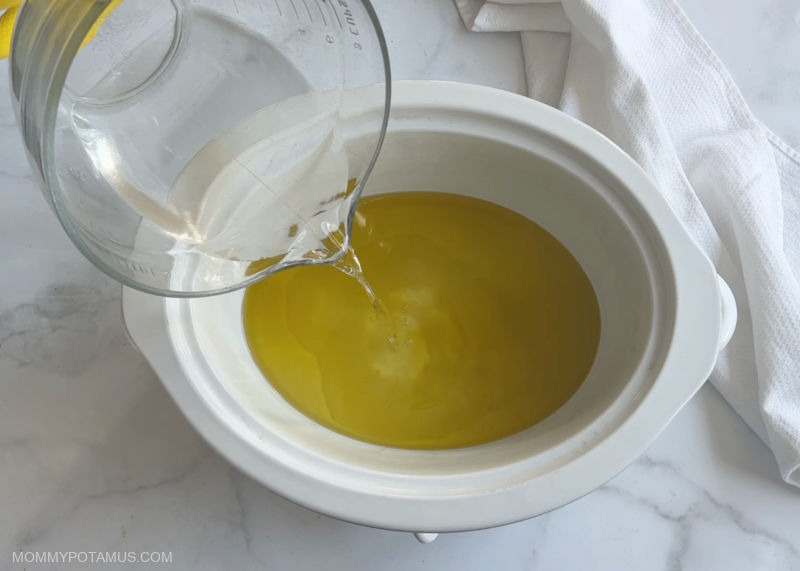
Gently pour the lye solution into the slow cooker (be careful not to splash) and stir a few times with your spatula or long-handled spoon.
Step 5: Blend Mixture To Trace
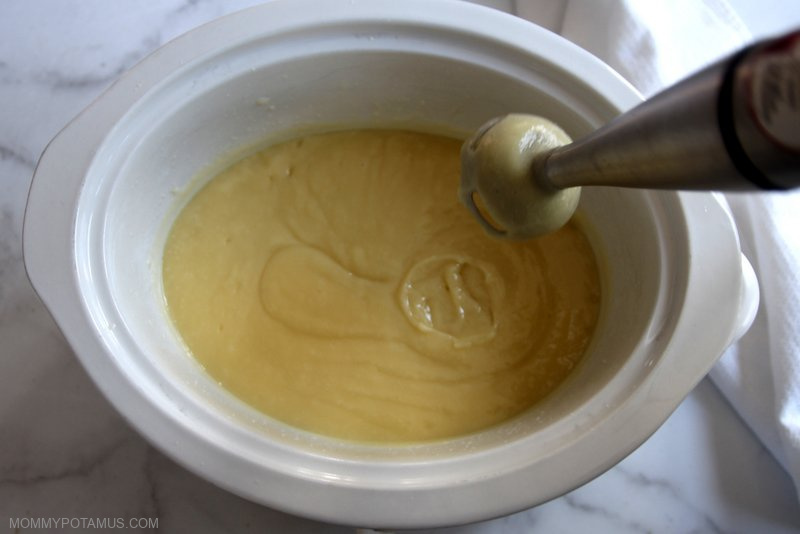
Using your stick blender begin mixing toward “light trace,” which is when the mixture develops the texture and thickness of a light pudding.
I’ve found that if I mix while holding the immersion blender straight down instead of at an angle it doesn’t splatter outside of the container, which keeps my protective equipment clean and reduces cleanup.
Cover and continue to let it cook on low heat.
Step 6: Check And Stir
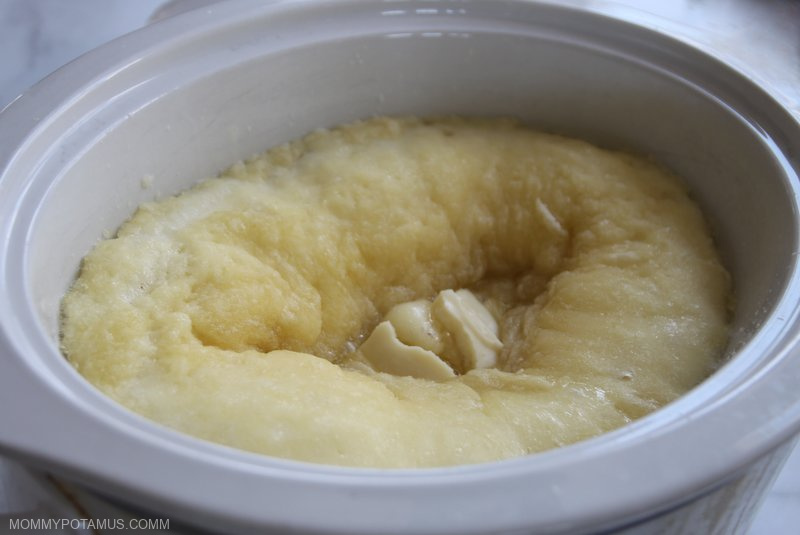
After the soap has been cooking for about 10 minutes, I check on it and give it a stir. During the cooking process the oils should rise up the sides like a wave and then fold back into the mixture, but sometimes if they’re not stirred often enough they can overflow out of the slow cooker.
After the first 10 minute check, I stir the soap every 15 minutes until a total of 45-60 minutes has passed.
Step 7: Check for Doneness
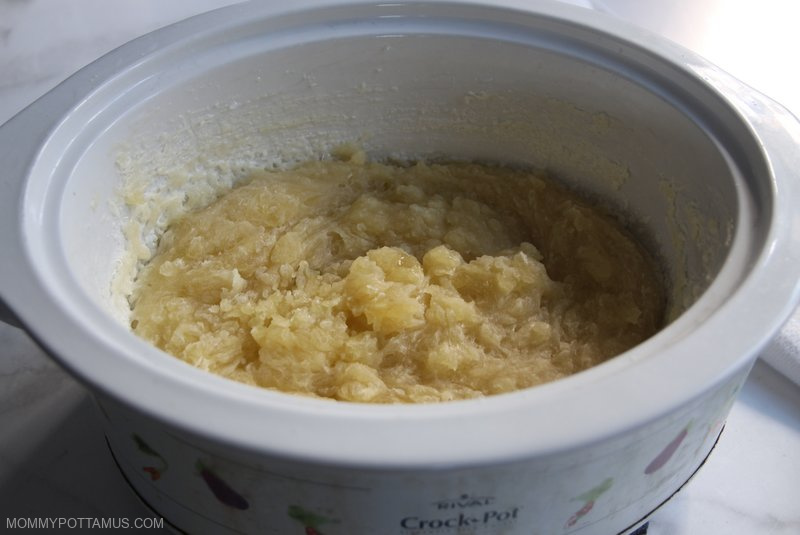
When the soap is ready, it should look like soft, fluid mashed potatoes. Here’s how to test your soap for readiness according to Dr. Kevin Dunn, author of Scientific Soapmaking”
“1) Take a gloved finger and wet it.
2) Rub the wet finger over the surface of your soap to gather up a coating of diluted soap/lather (does not have to be frothing). [Note from Heather: Since I use the hot process method, I rub my finger on soap that has dried and cooled on the silicone spatula I use to stir with.]
3 Very carefully touch the lather on your finger to only the very tip of your tongue – i.e., behave as if your finger might be covered with something gross or dangerous, instead of covered with something delicious like chocolate. Don’t go licking the bar of soap itself, and don’t go rubbing your lathered finger all over your tongue. Just a quick touch or 2 of your lathered finger to the very tip of your tongue is all it takes to be able to detect excess alkali/unreacted lye in your soap, which will make itself known by a zapping or stinging sensation on the tip of your tongue.
4) Repeat the above on each side of your soap.
5) Rinse your mouth out with water (or lemon juice if you desire) and spit.”
If there’s no zapping or stinging sensation, it’s ready. If you don’t want to do this test, the only other reliable testing method I know of is to purchase a waterproof pH tester kit and make sure the soap ph is between 8-10.
Note: It’s really important to make sure the soap is finished cooking and therefore all the lye is converted – otherwise it can burn skin.
Step 8: Add Essential Oils (Optional)
If you’re adding essential oils, wait until the mixture cools to 140°F – using your thermometer to check – then add them. Otherwise the heat will evaporate the essential oils instead of allowing them to blend into the soap.
Step 9: Spoon Soap Into Mold
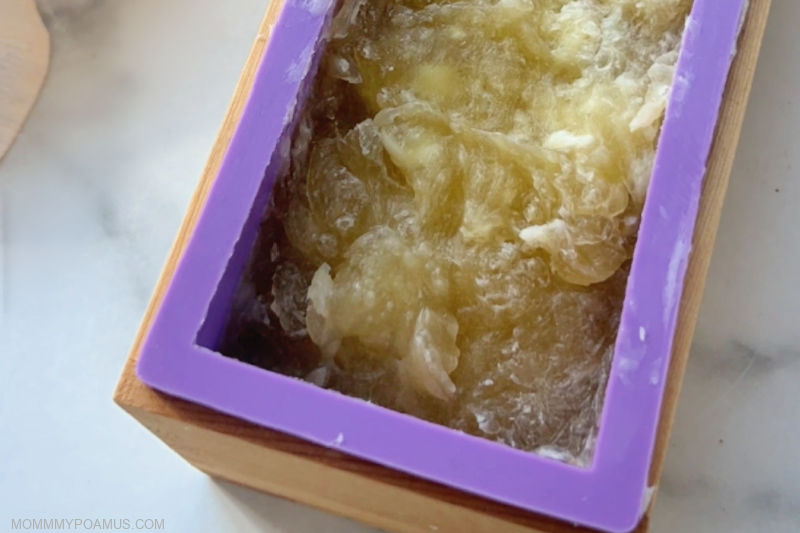
Spoon the soap into your mold and firmly tap it on your work surface – or the floor – a few times to get rid of any air bubbles. It shouldn’t splash, but just in case make sure you’re still wearing your protective gear.
Fill your sink with hot, soapy water and wash all tools well while wearing your protective equipment. Rinse very well after washing.
Step 10: Cut & Dry
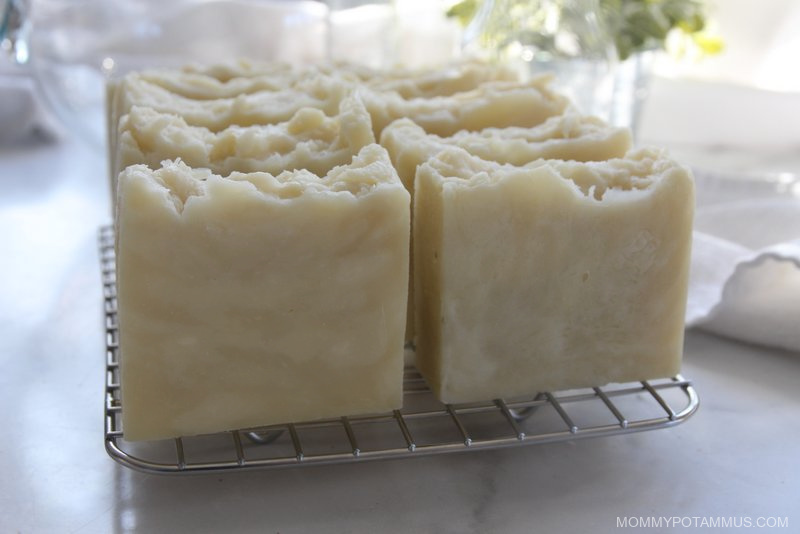
Let the soap set for 24 hours, then cut into bars. The mold I use will make ten 1-inch bars that are roughly 3.5 ounces each.
Your soap can be used right away, but the bars will last longer if they’re allowed harden for a bit. I usually grab one to use and then place the rest on a rack/tray for a week or two. Make sure they’re in an area with good airflow and have about an inch of space between them.
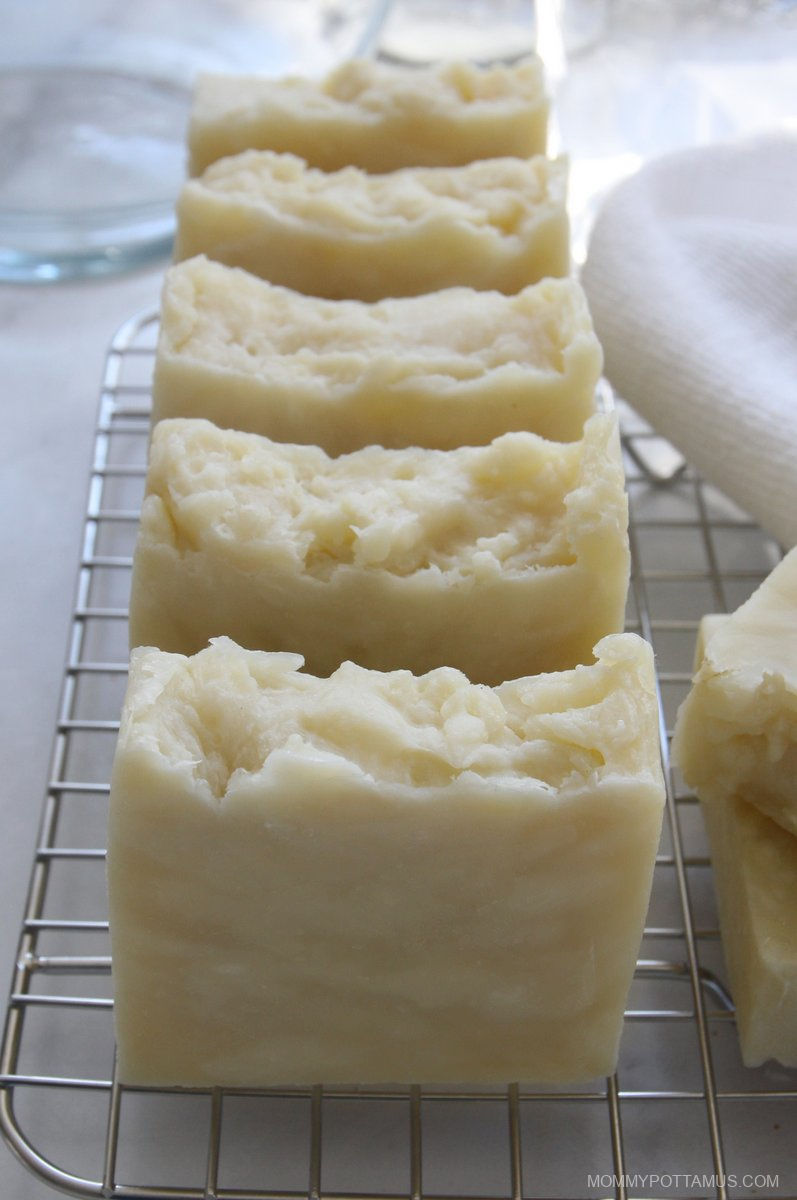
Frequently Asked Questions
If you don’t see your question answered here, please let me know in the comments!
How many bars of soap will this make?
It depends on how large you cut each bar, but in general this recipe will make ten to eleven 3.5 oz bars.
What are some tips for adding lye to water?
Add the lye to the water either outside or in a well-ventilated area. I personally add it outside, but some soapers use their kitchen sink as the mixing area after opening several windows and turning a fan or air purifier on.
When the lye is added, it will become hot and release vapors which is why you want to be in a well ventilated area. When I mix mine I can see the vapors rising (they look like steam) so I just lean my head away and don’t breathe them in.
While the lye is cooling it should not be in an area that is accessible to children or pets.
When mixing lye or blending soap, protect the area with packing paper or something similar to keep the lye from getting on surfaces.
What is 76 degree coconut oil?
Coconut oil is usually solid at temperatures below 76F, but it melts and becomes liquid when in a room that’s above 76F. However, some forms of coconut oil such as fractionated coconut oil remain in liquid form even when the temperature drops below 76F.
Can I replace one of the oils you suggest with one of my choosing?
Often, yes, but each oil/fat has a unique saponification value, which is the amount of lye needed to trigger the natural chemical reaction that transforms fats into soap
For example, it takes 0.13 grams of lye to convert one gram of shea butter into soap, but only about half (0.07) is needed to convert the same amount of jojoba oil into soap.
In soap making, the goal is for all of the lye needs to be used up in the conversion process, with a little leftover fat/oil in the soap to add moisturizing properties. There shouldn’t be any lye left in the finished bar of soap, because it’s very alkaline and can burn skin.
Yes, it’s important to be careful with lye, but it’s also important not to get orange essential oil on your skin before going out to play in the sunshine. My youngest found that out after eating an orange (sloppily, I would guess) and then heading outside to play in our Florida neighborhood. Orange oil, even from actual orange peels, is phototoxic, meaning it increases sensitivity to the sun.
Fortunately, the burn caused by the orange oil fully healed, but it’s a great example of why it’s important to be mindful about exposing our skin (even to natural things).
So back to soap: If you decided to swap jojoba oil for shea butter in a recipe but used the original amount of lye that was called for, you’d end up with soap that still had unconverted lye in it. You definitely don’t want that, so if you change the recipe in any way you will need to use a soap calculator to recalculate what is needed for your new blend.
Also, something to keep in mind is even when two fats have a similar lye requirement, they often yield very different properties in soap, For example, beef tallow and lard can technically be used interchangeably in this recipe, although the superfat ratio (amount of moisturizing oil present in the bar) will be lower with the lard.
However, the lather will be very different – more dense and creamy instead of cleansing and bubbly.
Can I make this soap with the cold process method?
Yes.
What is the superfat ratio of this recipe?
Because its superfatted to 5%, which means that there’s only enough lye to convert 95% of the oils to soap. About 5% of the nourishing fat/oils remain present in the finished soap.
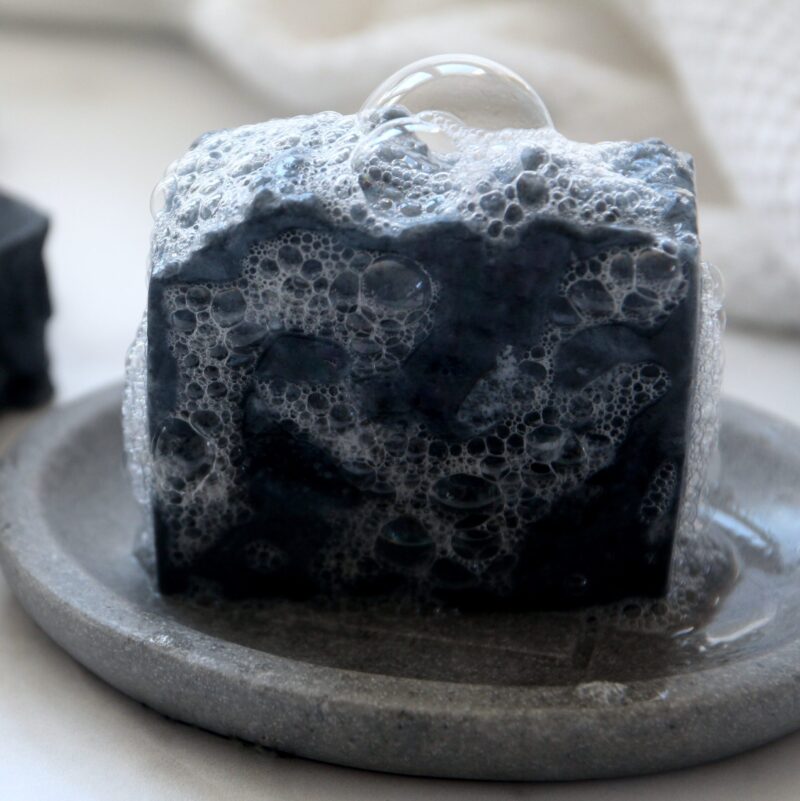
More Natural Soap Recipes To Try
DIY Activated Charcoal Soap – This recipe is a favorite with people who want clear, fresh looking skin. Many users report that it reduces the appearance of pore size by drawing out excess dirt and grime.
Pure Coconut Oil Soap – When it comes to soap, this is probably the easiest recipe you’ll ever make. It’s moisturizing and bubbly, and all you need are three simple ingredients.
Tallow Soap Recipe
Equipment
- Bowls for measuring your fats and oils
- Medium-size heat resistant glass bowl for mixing the lye water
- Stainless steel or plastic spoon with long handle (
- Protective equipment: shirt with long sleeves, plastic/rubber gloves, safety glasses or protective eye gear
- Thermometer (Optional – only needed if you're adding essential oils)
- Sink filled with hot soapy water (For cleaning anything that comes in contact with lye. Wait until you're ready to clean to fill the sink. Details below)
Ingredients
- 15 ounces beef tallow (click here for my guide to rendering tallow)
- 7.5 ounces coconut oil, 76 degree
- 7.5 ounces olive oil
- 11.4 ounces distilled water
- 4.3 ounces lye crystals (known as sodium hydroxide or NaOH)
- ½-1 ounce essential oil (optional)
Instructions
- Measure Your Ingredients Weigh all your ingredients: tallow, coconut oil, olive oil, distilled water, lye and optional essential oils if using.
- Melt The Tallow & Oils: Add the tallow, coconut oil and olive oil to the slow cooker and set it to low heat. When they are almost fully melted move on to step 3.
- Mix The Lye Water: Make sure that kids and pets do not have access to the lye water you are about to make, then put on your protective gear and add your water to a medium-sized heat-resistant glass or ceramic bowl.Choose a well-ventilated area to mix in the lye. I prefer to mix outside, but some soapers like to mix in their kitchen sink with several open windows and a fan or air purifier running. If you're new to working with lye, see the FAQ section for safety information.Make sure you have a long-handled spoon or spatula ready. I use a this silicone spatula/scraper.While wearing your protective gear and taking care not to breathe the vapors, slowly add the lye to the water while mixing gently. Order is important here, so make sure it is the lye you’re pouring into the water.Keep stirring until the lye seems mostly dissolved. The mixture will be cloudy at first, but will turn clear in 5-10 minutes. When it's clear, go to step 4.
- Add The Lye Mixture To The Slow Cooker: Gently pour the lye solution to the slow cooker (be careful not to splash) and stir a few times with your spatula or long-handled spoon.
- Blend Mixture To Trace: Using your stick blender begin mixing toward “light trace,” which is when the mixture develops the texture and thickness of a light pudding.I've found that if I mix while holding the immersion blender straight down instead of at an angle it doesn't splatter outside of the container, which keeps my protective equipment clean and reduces cleanup. Cover and continue to let it cook on low heat.
- Check And Stir: After the soap has been cooking for about 10 minutes, I check on it and give it a stir. During the cooking process the oils should rise up the sides like a wave and then fold back into the mixture, but sometimes if they're not stirred often enough they can overflow out of the slow cooker.After the first 10 minute check, I stir the soap every 15 minutes until a total of 45-60 minutes has passed.
- Check for Doneness: When the soap is ready, it should look like soft, fluid mashed potatoes. Here's how to test your soap for readiness according to Dr. Kevin Dunn, author of Scientific Soapmaking”"1) Take a gloved finger and wet it.2) Rub the wet finger over the surface of your soap to gather up a coating of diluted soap/lather (does not have to be frothing). [Note from Heather: Since I use the hot process method, I rub my finger on soap that has dried and cooled on the silicone spatula I use to stir with.]3 Very carefully touch the lather on your finger to only the very tip of your tongue – i.e., behave as if your finger might be covered with something gross or dangerous, instead of covered with something delicious like chocolate. Don't go licking the bar of soap itself, and don't go rubbing your lathered finger all over your tongue. Just a quick touch or 2 of your lathered finger to the very tip of your tongue is all it takes to be able to detect excess alkali/unreacted lye in your soap, which will make itself known by a zapping or stinging sensation on the tip of your tongue.4) Repeat the above on each side of your soap.5) Rinse your mouth out with water (or lemon juice if you desire) and spit."If there's no zapping or stinging sensation, it's ready. If you don't want to do this test, the only other reliable testing method I know of is to purchase a waterproof pH tester kit and make sure the soap ph is between 8-10.Note: It's really important to make sure the soap is finished cooking and therefore all the lye is converted – otherwise it can burn skin.
- Add Essential Oils (Optional): If you’re adding essential oils, wait until the mixture cools to 140°F – using your thermometer to check – then add them. Otherwise the heat will evaporate the essential oils instead of allowing them to blend into the soap.
- Spoon Soap Into Mold – Scoop the soap into your mold and firmly tap it on your work surface – or the floor – a few times to get rid of any air bubbles. It shouldn't splash, but just in case make sure you're still wearing your protective gear. Fill your sink with hot, soapy water and wash all tools well while wearing your protective equipment. Rinse very well after washing.
- Cut & Dry: Let the soap set for 24 hours, then cut into bars. The mold I use will make ten 1-inch bars that are roughly 3.5 ounces each.Your soap can be used right away, but the bars will last longer if they're allowed harden for a bit. I usually grab one to use and then place the rest on a rack/tray for a week or two. Make sure they’re in an area with good airflow and have about an inch of space between them.Frequently Asked QuestionsIf you don't see your question answered here, please let me know in the comments!
FREE Ebook: DIY Body Care Gifts Made Simple
Do you want to give gorgeous, handcrafted gifts for family and friends, without spending a bunch of time on them?
Then I’d love to give you a free copy of DIY Body Care Gifts Made Simple – my step-by-step guide to making gorgeous handcrafted gifts without stressing yourself out – as a gift for signing up for my newsletter. I’ll show you how to make vintage labels, luxurious lotion bars, lip balms, sugar scrubs, body sprays and more like a pro. Sign up for my newsletter and you’ll be redirected to the download page immediately!

